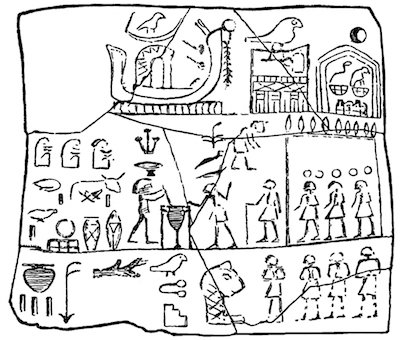Hor Aha (aka Aha or Horus Aha,”Fighting Hawk”) may have been the son of Narmer and his queen, Neithhotep, although Lesko (1999) suggests that he was the husband of Neithhotep.

He is the first human ruler named in the Palermo Stone, and so is often regarded as the first pharaoh of the first dynasty. However, the ancient kings lists found in the tombs of Den and Qa’a record him as the second ruler after Narmer.
Hor Aha is depicted on an ivory label (below) found in the tomb of Neithotep (Saqqara) performing a ceremony called “receiving the South and the North” which is thought to have celebrated the unity of Upper and Lower Egypt. His Horus name (Aha) is written in a serekh in the top right hand corner of the label and to its right there is what appears to be a Nebti (two ladies – referring to Wadjet and Nekhbet the patron goddesses of Upper and Lower Egypt) named “Men” (established).

Because of this he is considered by many authorities to be Menes (referred to by Manetho as the founder of the first dynasty) and Min (who Herodotus regarded as the founder of the first dynasty). However, it is also proposed that his Nebti name was Ity (Edwards, 1971) a name associated with Djer (his successor and possibly his son) by other scholars.

This situation is complicated by the fact that the Turin Cannon lists Men as the first human ruler, followed by Teti and then Ity. If Narmer is to be associated with Men we would expect Aha to have the nomen Teti. Perhaps for this reason some authorities have suggested that Aha was in fact the ruler referred to by Manetho as Athothis.
In part because of his association with Min he is generally credited with founding Men Nefer (Memphis in the 1st nome of Lower Egypt) at a strategically important spot. According to Herodotus he constructed a dam to reclaim land on which to found the city. Manetho records that he reigned from Men Nefer for sixty-two years before being killed by a hippopotamus (an animal which was associated with the god Set who was the archetypal foe of Horus).
Wilkinson suggests that during his reign peaceful trading with Palestine was replaced by a more aggressive exploitation of the peoples and resources of that area. Unlike Narmer, no fragments bearing his name have been recovered from outside Egypt while fragments found in contemporary noble’s tombs refer to rebels in Nubia, and foreign campaigns.
A legend tells that the king was attacked by wild dogs in the Faiyum, but his life was saved by a crocodile. According to this tale, he thanked Sobek (the crocodile god) by founding the city of Per Sobek (“House of Sobek”, in the 21st nome of Upper Egypt – an area later known to the Greeks as Crocodilopolis).
Aha seems to have constructed tombs at both Saqqara and Abdyos. The tombs were not decorated, and many were looted and damaged by tomb robbers and early archaeologists (e.g. Amelineau), but a few labels and fragments have been recovered. Emery attributed tomb 3357 at Saqqara to him because his name was found on seal impressions discovered there, however, his name was also found on a stone vessel recovered from tomb 3036 and tomb 3357 is now attributed to an unknown official of Aha’s reign.
It is now believed that Aha was buried in Abydos in tombs B10, B15 and B19 (which were originally thought to have been three separate tombs). His tomb had five subterranean chambers and twenty-seven storerooms above ground. The outside of his tomb was decorated to resemble a palace facade and a boat pit on the northern side of the tomb is thought to have held a wooden solar boat. There were thirty-three subsidiary burials of servants and officials who may have been killed or committed suicide to join the king in the afterlife (as none were over the age of twenty-five) and the graves of seven young male lions.

Closer to his Abydos tomb is the tomb of Berner-ib (B14). She is considered to have been Aha’s wife as she also appears on fragments found in Queen Neithotep’s tomb (suggesting that Neithhotep was not Aha’s wife). The Cairo Annals Stone confirms that Djer’s mother was Khenthap, who may have been another wife of Aha.
Pharaoh’s Names
- Manetho; Menes, the first king of Egypt or Athothis, Manetho’s second king
- Herodotus; Min (disputed)
- The Abydos Kings list; Meni or Teti
Nomen; Teti (recorded on the Abydos kings list)

Nomen; Ity (recorded on the Turin list)

Throne name; Min (Men)

Bibliography
- Kathryn Bard (2008) An introduction to the Archaeology of Ancient Egypt
- Peter A Clayton (1994) Chronicle of the Pharaohs
- A. Dodson and D. Hilton (2004) The Complete Royal Families of Ancient Egypt
- I.E.S. Edwards (1971) The Cambridge Ancient History, Vol 1 part 2 (Early History of the Middle East)
- Barry J Kemp (1991) Ancient Egypt: Anatomy of a Civilisation
- Barbara S. Lesko (1999) The great goddesses of Egypt
- Beatrix Midant-Reynes (1992, translation by I Shaw 2000) Prehistory of Egypt
- N. B. Millett. (1990) The Narmer Macehead and related objects. Journal of the American Research Center in Egypt XXVII
- H.S. Smith (1992) The Making of Egypt
- B.G. Trigger et al (1983) Ancient Egypt, A Social History
- Toby A H Wilkinson (1999) Early Dynastic Egypt
- Toby A H Wilkinson (2000) What a King Is This: Narmer and the Concept of the Ruler from The Journal of Egyptian Archaeology
- Hilary Wilson (1997) People of the Pharaohs
Copyright J Hill 2010